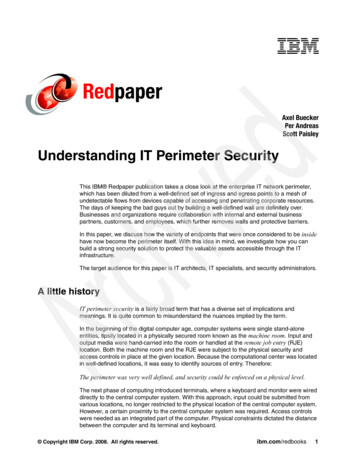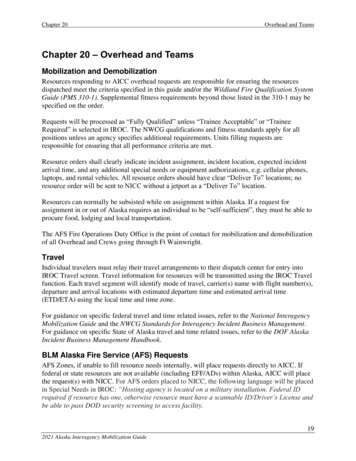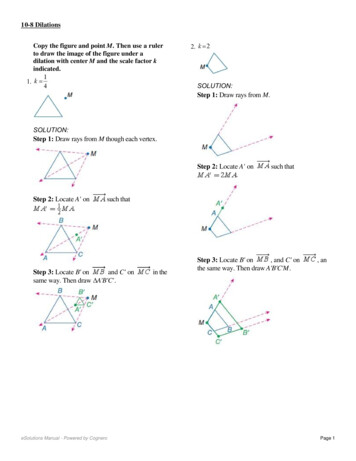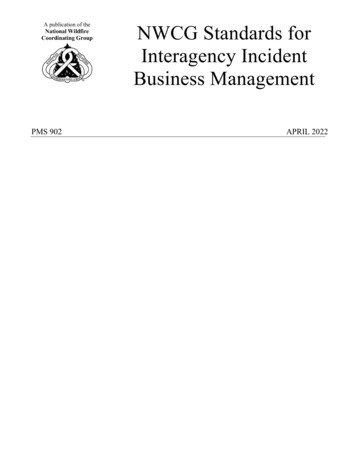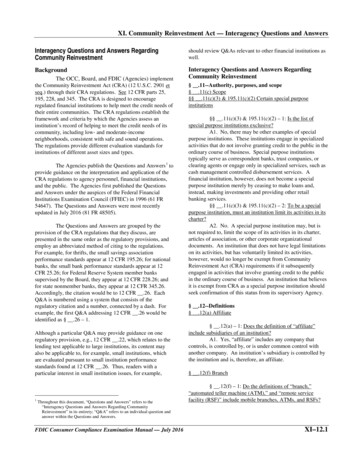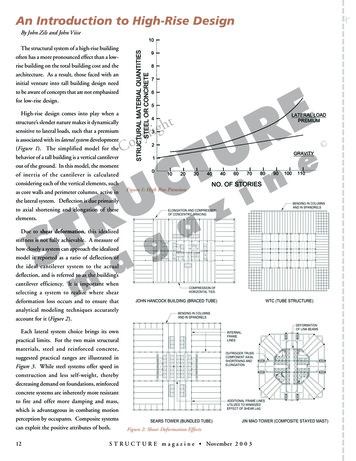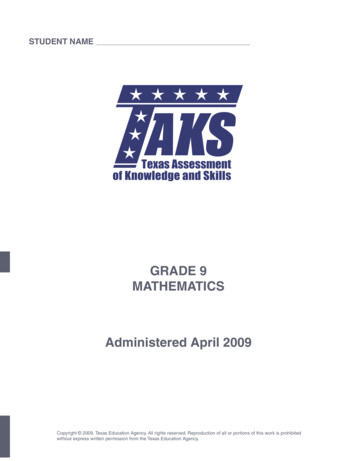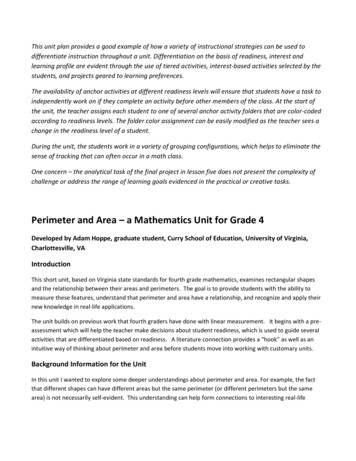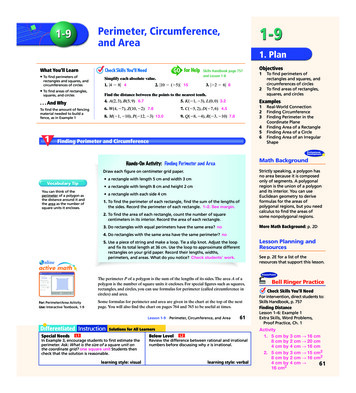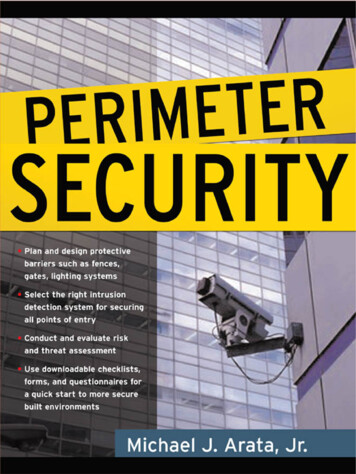
Transcription
Perimeter SecurityMichael J. Arata, Jr.McGraw-HillNew York Chicago San Francisco Lisbon London MadridMexico City Milan New Delhi San Juan SeoulSingapore Sydney Toronto
Copyright 2006 by The McGraw-Hill Companies, Inc. All rights reserved. Manufactured in the United States of America. Exceptas permitted under the United States Copyright Act of 1976, no part of this publication may be reproduced or distributed in any formor by any means, or stored in a database or retrieval system, without the prior written permission of the publisher.0-07-158916-3The material in this eBook also appears in the print version of this title: 0-07-146028-4.All trademarks are trademarks of their respective owners. Rather than put a trademark symbol after every occurrence of a trademarked name, we use names in an editorial fashion only, and to the benefit of the trademark owner, with no intention ofinfringement of the trademark. Where such designations appear in this book, they have been printed with initial caps.McGraw-Hill eBooks are available at special quantity discounts to use as premiums and sales promotions, or for use in corporatetraining programs. For more information, please contact George Hoare, Special Sales, at george hoare@mcgraw-hill.com or (212)904-4069.TERMS OF USEThis is a copyrighted work and The McGraw-Hill Companies, Inc. (“McGraw-Hill”) and its licensors reserve all rights in and to thework. Use of this work is subject to these terms. Except as permitted under the Copyright Act of 1976 and the right to store andretrieve one copy of the work, you may not decompile, disassemble, reverse engineer, reproduce, modify, create derivative worksbased upon, transmit, distribute, disseminate, sell, publish or sublicense the work or any part of it without McGraw-Hill’s priorconsent. You may use the work for your own noncommercial and personal use; any other use of the work is strictly prohibited. Yourright to use the work may be terminated if you fail to comply with these terms.THE WORK IS PROVIDED “AS IS.” McGRAW-HILL AND ITS LICENSORS MAKE NO GUARANTEES OR WARRANTIESAS TO THE ACCURACY, ADEQUACY OR COMPLETENESS OF OR RESULTS TO BE OBTAINED FROM USING THEWORK, INCLUDING ANY INFORMATION THAT CAN BE ACCESSED THROUGH THE WORK VIA HYPERLINK OR OTHERWISE, AND EXPRESSLY DISCLAIM ANY WARRANTY, EXPRESS OR IMPLIED, INCLUDING BUT NOT LIMITED TOIMPLIED WARRANTIES OF MERCHANTABILITY OR FITNESS FOR A PARTICULAR PURPOSE. McGraw-Hill and itslicensors do not warrant or guarantee that the functions contained in the work will meet your requirements or that its operation willbe uninterrupted or error free. Neither McGraw-Hill nor its licensors shall be liable to you or anyone else for any inaccuracy, erroror omission, regardless of cause, in the work or for any damages resulting therefrom. McGraw-Hill has no responsibility for the content of any information accessed through the work. Under no circumstances shall McGraw-Hill and/or its licensors be liable for anyindirect, incidental, special, punitive, consequential or similar damages that result from the use of or inability to use the work, evenif any of them has been advised of the possibility of such damages. This limitation of liability shall apply to any claim or cause whatsoever whether such claim or cause arises in contract, tort or otherwise.DOI: 10.1036/0071460284
ProfessionalWant to learn more?We hope you enjoy thisMcGraw-Hill eBook! Ifyou’d like more information about this book,its author, or related books and websites,please click here.
DEDICATIONThis book is dedicated to my wife, Karla, for putting up with me during the writing of this book; and to my daughter, Kristen; and son, Jimmy, without whosepatience and understanding of late nights and weekends spent writing and rewriting, this book would not have been possible.ACKNOWLEDGMENTThank you Victoria Roberts of Lone Wolf Enterprises for the excellent, expertjob you did in editing and guidance; without it this project would not have beenpossible.ABOUT THE AUTHORMichael Arata has over 15 years of security experience that includes positionsfrom manager to vice president and consultant. He has developed and managedsuccessful security programs from the ground up for several large organizationsincluding the Director of Corporate Security for a major West Coast construction company.He holds a master’s degree in Public Administration, a B.A. in Business/Public Administration, and a B.S. in Safety and Fire Protection Technology. He hasattended numerous seminars and training programs relating to security and holdsCISSP, CPP, CFE and ACLM, professional certifications.He has spoken at various professional organization seminars on the subject ofsecurity and written articles about security for trade publications. He has guestlectured at the Oklahoma State University and the University of California,Berkeley on safety and security related subjects. He is an adjunct instructor ofCriminal Justice at a local college.Copyright 2006 by The McGraw-Hill Companies, Inc. Click here for terms of use.
For more information about this title, click hereContentsCHAPTER 1 INTRODUCTION . . . . . . . . . . . . . . . . . . . . . . . . 1CHAPTER 2 THREAT ASSESSMENT AND RISK ANALYSISBASICS . . . . . . . . . . . . . . . . . . . . . . . . . . . . . . . . 5How to Do a Threat Assessment . . . . . . . . . . . . . . . . . . . . 6Identify the Risks . . . . . . . . . . . . . . . . . . . . . . . . . . . . . . . 7Analyze the Risk for Probability of Occurrence . . . . 8Calculating the Cost of a Loss . . . . . . . . . . . . . . . . . . 10The Survey Form . . . . . . . . . . . . . . . . . . . . . . . . . . . . . . . 11The Crime Statistics . . . . . . . . . . . . . . . . . . . . . . . . . . . 22Risk Analysis Steps . . . . . . . . . . . . . . . . . . . . . . . . . . . . 24Choosing the Method to Mitigate the Risk . . . . . . . 26Planning and Designing . . . . . . . . . . . . . . . . . . . . . . . . . . . 29CHAPTER 3 PERIMETER FENCE . . . . . . . . . . . . . . . . . . . . . 33Types of Perimeter Fences . . . . . . . . . . . . . . . . . . . . . . . . 34Chain Link . . . . . . . . . . . . . . . . . . . . . . . . . . . . . . . . . . . . 35Wrought Iron . . . . . . . . . . . . . . . . . . . . . . . . . . . . . . . . . 37Wood Fences . . . . . . . . . . . . . . . . . . . . . . . . . . . . . . . . . 39Concrete Walls . . . . . . . . . . . . . . . . . . . . . . . . . . . . . . . . 41Fence Openings . . . . . . . . . . . . . . . . . . . . . . . . . . . . . . . . . . 41Barbed Wire . . . . . . . . . . . . . . . . . . . . . . . . . . . . . . . . . . . . . 43Razor Wire . . . . . . . . . . . . . . . . . . . . . . . . . . . . . . . . . . . . . . 44Fence Design Specifications . . . . . . . . . . . . . . . . . . . . . . . 45CHAPTER 4 PROTECTIVE BARRIERS . . . . . . . . . . . . . . . . 49Natural Protective Barriers . . . . . . . . . . . . . . . . . . . . . . . 50Man-Made Protective Barriers . . . . . . . . . . . . . . . . . . . . . 51Decorative Planters . . . . . . . . . . . . . . . . . . . . . . . . . . . . 52Bollards . . . . . . . . . . . . . . . . . . . . . . . . . . . . . . . . . . . . . . 53K-Rail . . . . . . . . . . . . . . . . . . . . . . . . . . . . . . . . . . . . . . . . 55Welded Steel Guard Rails . . . . . . . . . . . . . . . . . . . . . . 56Vehicle Arrest Systems . . . . . . . . . . . . . . . . . . . . . . . . . 57ivBerms and Ditches . . . . . . . . . . . . . . . . . . . . . . . . . . . . 59Design Considerations for Protective Barriers . . . . . . 59Conclusion . . . . . . . . . . . . . . . . . . . . . . . . . . . . . . . . . . . . . . 60CHAPTER 5 SECURITY LIGHTING . . . . . . . . . . . . . . . . . . . 61Foot-Candle Power . . . . . . . . . . . . . . . . . . . . . . . . . . . . . . . 63Categories of Security Lighting . . . . . . . . . . . . . . . . . 63Types of Lamps (Luminaries) . . . . . . . . . . . . . . . . . . . 64Types of Security Lighting . . . . . . . . . . . . . . . . . . . . . . 65Lighting Requirements for Perimeter Protection . . . . 65Lighting Requirements for CCTV . . . . . . . . . . . . . . . . . . 68Electrical Power Sources for Security Lighting . . . . . . 69Wiring and Lighting Controls . . . . . . . . . . . . . . . . . . . 70Maintenance of Lighting Systems . . . . . . . . . . . . . . . . . . 71Security Lighting Design Considerations . . . . . . . . . . . . 71Conclusion . . . . . . . . . . . . . . . . . . . . . . . . . . . . . . . . . . . . . . . 73CHAPTER 6 ELECTRONIC ACCESS CONTROL . . . . . . . 75Biometric Systems . . . . . . . . . . . . . . . . . . . . . . . . . . . . . . . 75Hand Geometry . . . . . . . . . . . . . . . . . . . . . . . . . . . . . . . 76Fingerprint Reader . . . . . . . . . . . . . . . . . . . . . . . . . . . . . 76Iris Scanner . . . . . . . . . . . . . . . . . . . . . . . . . . . . . . . . . . . 76Retina Scan . . . . . . . . . . . . . . . . . . . . . . . . . . . . . . . . . . . 77Voice Recognition . . . . . . . . . . . . . . . . . . . . . . . . . . . . . 77Signature Recognition . . . . . . . . . . . . . . . . . . . . . . . . . 77Facial Recognition . . . . . . . . . . . . . . . . . . . . . . . . . . . . . 77Error Rates . . . . . . . . . . . . . . . . . . . . . . . . . . . . . . . . . . . 78Combination Systems . . . . . . . . . . . . . . . . . . . . . . . . . . . . 78Access Control System Cards . . . . . . . . . . . . . . . . . . . . . 78Magnetic Strip . . . . . . . . . . . . . . . . . . . . . . . . . . . . . . . . 78Proximity Cards . . . . . . . . . . . . . . . . . . . . . . . . . . . . . . . 80Smart Cards . . . . . . . . . . . . . . . . . . . . . . . . . . . . . . . . . . 80
ContentsDual Technology Cards . . . . . . . . . . . . . . . . . . . . . . . . 80Designing the Access Control System . . . . . . . . . . . . . . 80Types of Access Control System Locks . . . . . . . . . . . . . 82Request to Exit Device (REX) . . . . . . . . . . . . . . . . . . . . . . 84Door Contacts . . . . . . . . . . . . . . . . . . . . . . . . . . . . . . . . . . . 85Automatic Door Closer . . . . . . . . . . . . . . . . . . . . . . . . . . . 85Access Control System Panels . . . . . . . . . . . . . . . . . . . . . 86Sample Design Specifications . . . . . . . . . . . . . . . . . . . . . 86CHAPTER 7 ALARMS (INTRUSION DETECTIONSYSTEMS) . . . . . . . . . . . . . . . . . . . . . . . . . . . 101Alarm Categories . . . . . . . . . . . . . . . . . . . . . . . . . . . . . . . 102Exterior Intrusion Detection Sensors . . . . . . . . . . . 102Interior Intrusion Detection Sensors . . . . . . . . . . . . . . 103Sensor Technology . . . . . . . . . . . . . . . . . . . . . . . . . . . 103Switches . . . . . . . . . . . . . . . . . . . . . . . . . . . . . . . . . . . . . . . 104Magnetic Switches . . . . . . . . . . . . . . . . . . . . . . . . . . . 104Balanced Magnetic Switches . . . . . . . . . . . . . . . . . . 105Mechanical Switches . . . . . . . . . . . . . . . . . . . . . . . . . 106Volumetric Sensors . . . . . . . . . . . . . . . . . . . . . . . . . . . . . 107Ultrasonic Sensors . . . . . . . . . . . . . . . . . . . . . . . . . . . . 107Infrared . . . . . . . . . . . . . . . . . . . . . . . . . . . . . . . . . . . . . 109Glass Breaks . . . . . . . . . . . . . . . . . . . . . . . . . . . . . . . . . . . . . 116Microwave . . . . . . . . . . . . . . . . . . . . . . . . . . . . . . . . . . . . . . 117Vibration Sensors . . . . . . . . . . . . . . . . . . . . . . . . . . . . . . . . 121Fence Vibration Sensors . . . . . . . . . . . . . . . . . . . . . . . 123Fiber Optic . . . . . . . . . . . . . . . . . . . . . . . . . . . . . . . . . . 123Electric Field . . . . . . . . . . . . . . . . . . . . . . . . . . . . . . . . . 126Capacitance . . . . . . . . . . . . . . . . . . . . . . . . . . . . . . . . . 127Taut Wire . . . . . . . . . . . . . . . . . . . . . . . . . . . . . . . . . . . 128Photo Electric Beam . . . . . . . . . . . . . . . . . . . . . . . . . . 130Video Motion Detection . . . . . . . . . . . . . . . . . . . . . . . 131Intrusion Detection System Design Specifications . 132CHAPTER 8 PARKING LOTS AND GARAGES . . . . . . . . 141Physical Design Features That Enhance Security . . . 142Natural Surveillance . . . . . . . . . . . . . . . . . . . . . . . . . . 142Territorial Reinforcement . . . . . . . . . . . . . . . . . . . . . 142Natural Access Control . . . . . . . . . . . . . . . . . . . . . . . 143Target Hardening . . . . . . . . . . . . . . . . . . . . . . . . . . . . . 142vParking Garages . . . . . . . . . . . . . . . . . . . . . . . . . . . . . . . . . 143Natural Access Control . . . . . . . . . . . . . . . . . . . . . . . 143Natural Surveillance . . . . . . . . . . . . . . . . . . . . . . . . . . 145Traditional Physical Security . . . . . . . . . . . . . . . . . . . 147Access Control . . . . . . . . . . . . . . . . . . . . . . . . . . . . . . . 149Security Officers . . . . . . . . . . . . . . . . . . . . . . . . . . . . . 149Security Survey . . . . . . . . . . . . . . . . . . . . . . . . . . . . . . 149Parking Lots . . . . . . . . . . . . . . . . . . . . . . . . . . . . . . . . . . . . 150Lighting in Parking Lots . . . . . . . . . . . . . . . . . . . . . . . . 151Landscaping in Parking Lots . . . . . . . . . . . . . . . . . . . . 152CCTV in Parking Lots . . . . . . . . . . . . . . . . . . . . . . . . . . 152Emergency Call Boxes . . . . . . . . . . . . . . . . . . . . . . . . . 153Security Officers . . . . . . . . . . . . . . . . . . . . . . . . . . . . . 153Sample Design Specifications for a Parking Garage . 153CHAPTER 9 CLOSED CIRCUIT TELEVISION (CCTV) . . 159CCTV System Components . . . . . . . . . . . . . . . . . . . . . . 160Camera . . . . . . . . . . . . . . . . . . . . . . . . . . . . . . . . . . . . . . 161Coaxial Cable . . . . . . . . . . . . . . . . . . . . . . . . . . . . . . . . 163Fiber Optic Cable . . . . . . . . . . . . . . . . . . . . . . . . . . . . . 163Microwave . . . . . . . . . . . . . . . . . . . . . . . . . . . . . . . . . . 164MUX . . . . . . . . . . . . . . . . . . . . . . . . . . . . . . . . . . . . . . . . 164Monitor . . . . . . . . . . . . . . . . . . . . . . . . . . . . . . . . . . . . . 165Recorders . . . . . . . . . . . . . . . . . . . . . . . . . . . . . . . . . . . 165Wireless Cameras . . . . . . . . . . . . . . . . . . . . . . . . . . . . 167IP Addressable Cameras . . . . . . . . . . . . . . . . . . . . . . . 167Basic System Design Considerations . . . . . . . . . . . . . . 168Lighting . . . . . . . . . . . . . . . . . . . . . . . . . . . . . . . . . . . . . . . . . 173CHAPTER 10 LOCKS AND KEYS . . . . . . . . . . . . . . . . . . . 175Types of Locks . . . . . . . . . . . . . . . . . . . . . . . . . . . . . . . . . . 176Keying Systems . . . . . . . . . . . . . . . . . . . . . . . . . . . . . . . . . 182Specifications . . . . . . . . . . . . . . . . . . . . . . . . . . . . . . . . . . . 183CHAPTER 11 DOORS AND WINDOWS . . . . . . . . . . . . . 195Types of Window Frames . . . . . . . . . . . . . . . . . . . . . . . . 195Types of Window Glass . . . . . . . . . . . . . . . . . . . . . . . 197Design Considerations for Doors and Windows . . . 206CHAPTER 12 DEFENSE-IN-DEPTH . . . . . . . . . . . . . . . . . . 215People and Defense-in-Depth . . . . . . . . . . . . . . . . . . . . 216
viPerimeter SecurityPhysical Security . . . . . . . . . . . . . . . . . . . . . . . . . . . . . 216Implementing the Physical Security . . . . . . . . . . . . . . 218The Perimeter Fence and Natural Barriers . . . . . . . . . 218Protective Lighting . . . . . . . . . . . . . . . . . . . . . . . . . . . . . . 219Access Control . . . . . . . . . . . . . . . . . . . . . . . . . . . . . . . . . 220Intrusion Detection . . . . . . . . . . . . . . . . . . . . . . . . . . . . . 221CCTV . . . . . . . . . . . . . . . . . . . . . . . . . . . . . . . . . . . . . . . . . . 222Locks and Keys . . . . . . . . . . . . . . . . . . . . . . . . . . . . . . . . . 222Windows and Doors . . . . . . . . . . . . . . . . . . . . . . . . . . . . 223Blast and Bullet Resistant Protection . . . . . . . . . . . . . 224Fire Protection . . . . . . . . . . . . . . . . . . . . . . . . . . . . . . . . . 224Protected Zones . . . . . . . . . . . . . . . . . . . . . . . . . . . . . . . . 225CHAPTER 13 SECURE AREAS IN A BUILDING . . . . . . . 227Design and Construction of the Secure Room . . . . . 228Design and Construction of the Secured(Caged) Area . . . . . . . . . . . . . . . . . . . . . . . . . . . . . . . . . 232Emergency Power . . . . . . . . . . . . . . . . . . . . . . . . . . . . . . . 234Design Considerations for Secure Rooms and SecureAreas . . . . . . . . . . . . . . . . . . . . . . . . . . . . . . . . . . . . . . . . . . 235CHAPTER 14 SECURITY DESIGN . . . . . . . . . . . . . . . . . . 241XYZ Pharmaceutical Company . . . . . . . . . . . . . . . . . . . 241Security Design for the XYZ PharmaceuticalCompany . . . . . . . . . . . . . . . . . . . . . . . . . . . . . . . . . . . 242Perimeter Security . . . . . . . . . . . . . . . . . . . . . . . . . . . . . . 245Continuous Lighting . . . . . . . . . . . . . . . . . . . . . . . . . . . . . 247Standby Lighting . . . . . . . . . . . . . . . . . . . . . . . . . . . . . . . . 247Movable Lighting . . . . . . . . . . . . . . . . . . . . . . . . . . . . . . . 247Emergency Lighting . . . . . . . . . . . . . . . . . . . . . . . . . . . . . 247Interior Security . . . . . . . . . . . . . . . . . . . . . . . . . . . . . . . . 248CCTV . . . . . . . . . . . . . . . . . . . . . . . . . . . . . . . . . . . . . . . . . . 249Fire Protection . . . . . . . . . . . . . . . . . . . . . . . . . . . . . . . . . 250Intrusion Detection . . . . . . . . . . . . . . . . . . . . . . . . . . . . . 250Alarm Annunciation . . . . . . . . . . . . . . . . . . . . . . . . . . . . . 253Sample Design Specifications . . . . . . . . . . . . . . . . . . . . 255CHAPTER 15 PROTECTION OF UTILITIES (ELECTRIC,PHONE, WATER) . . . . . . . . . . . . . . . . . . . . 279Protecting Fiber Data Lines and T1 lines . . . . . . . . . . 280Securing the Manhole Covers . . . . . . . . . . . . . . . . . . . . 282Protecting the Electric Utility Vaults . . . . . . . . . . . . . 287Securing the Electrical Switchgear Room . . . . . . . . . 289Securing the Telephone Room/or Closet . . . . . . . . . 290Securing the Emergency Backup Power System . . . 292Securing the Water Lines and Wells on Site . . . . . . . 293CHAPTER 16 BLAST PROTECTION . . . . . . . . . . . . . . . . 295Assessment for Blast Protection . . . . . . . . . . . . . . . . . 298Physical Security Survey . . . . . . . . . . . . . . . . . . . . . . 300Blast-Hardening . . . . . . . . . . . . . . . . . . . . . . . . . . . . . . 301CHAPTER 17 FIRE PROTECTION . . . . . . . . . . . . . . . . . . . 313Fire Codes . . . . . . . . . . . . . . . . . . . . . . . . . . . . . . . . . . . . . . 313Fire Suppression Systems . . . . . . . . . . . . . . . . . . . . . . . . 315Wet Pipe Sprinkler Systems . . . . . . . . . . . . . . . . . . . . 316Dry Pipe Sprinkler Systems . . . . . . . . . . . . . . . . . . . . 317Gaseous Fire Suppression Systems . . . . . . . . . . . . . 318Smoke and Fire Detection Systems . . . . . . . . . . . . . . . 320Flame Detection . . . . . . . . . . . . . . . . . . . . . . . . . . . . . 322Emergency Backup Power . . . . . . . . . . . . . . . . . . . . . . . 322Deigning Fire Detection and Suppression Systems . 323CHAPTER 18 SOUND CONTROL . . . . . . . . . . . . . . . . . . 325Eavesdropping Devices - The Extent of the Threat . 325The Devices . . . . . . . . . . . . . . . . . . . . . . . . . . . . . . . . . 326Soundproofing a Room . . . . . . . . . . . . . . . . . . . . . . . . . . 328CHAPTER 19 SHIPPING AND RECEIVING . . . . . . . . . . . 333Physical Security for Shipping and Receiving . . . . . . 334Access Control . . . . . . . . . . . . . . . . . . . . . . . . . . . . . . . . . . 334Intrusion Detection . . . . . . . . . . . . . . . . . . . . . . . . . . . . . 335CCTV for Shipping and Receiving . . . . . . . . . . . . . . . . . 337Lighting . . . . . . . . . . . . . . . . . . . . . . . . . . . . . . . . . . . . . . . . 338Securing Shipping and Receiving . . . . . . . . . . . . . . . . . 339CHAPTER 20 CHECKLISTS AND FORMS . . . . . . . . . . . 341INDEX . . . . . . . . . . . . . . . . . . . . . . . . . . . . . . . . . . . . . . . . . . . . 353
CHAPTERIntroduction1The news today is filled with heightened awareness and sensitivity aboutphysical or perimeter security due to the threat of terrorism. What doesperimeter security mean? We will explore perimeter security in depth inthe book. Perimeter security is defined as the protection of the outer boundaryof your facility. With the advent of network security, perimeter security is defined as the protection of outer boundaries of the network. We are only going tofocus on physical perimeter security in the book.What does perimeter security entail? Perimeter security starts at the propertyline. This is either a natural or manmade barrier. In most cases it is the fence line.Then there are gates, lighting, the building or structure itself, walls, windows,doors, alarms, etc. Sometimes intrusion detection is used to monitor the perimeter fence line or the detectors are located in the ground. In the chapters that follow we are going to explore in detail each of the elements that make up perimeter security.In Chapter 2 we will examine the security survey and threat assessment. Youcan’t design effective perimeter security that also brings value to the companyor the owner without first understanding what you are protecting and who youare protecting it from. Therefore the security survey and threat assessment isthe first step. One important aspect is to obtain and understand the crime statistics for the area your project or building is located. The statistics can be obtained from the local police departments. There is also a company that will provide the information and you don’t need to purchase any software. All youneed to do is to give them an address and they will provide scores for that address based on certain data. The scores are a predictor of the occurrence ofcrime by type. There are checklists for performing a risk analysis and checklistsfor completing a security survey.1Copyright 2006 by The McGraw-Hill Companies, Inc. Click here for terms of use.
2Perimeter SecurityChapter 3 will outline the specifications for chain-link fences. The specifications are the Federal DOD requirements which are a standard in the security industry. The types of fences will also be discussed along with their uses. Sampledesign specifications are also presented.Chapter 4 is all about protective barriers and how they are effective in physical security and protecting the perimeter. The types of barriers will be presented.The designs and their uses will be discussed. Portable and permanent barrierstypes and uses are explained.Chapter 5 addresses protective lighting the types of systems, uses and the design of the protective lighting system to enhance perimeter security. The properillumination of lighting for security purposes is discussed and the definition of afoot-candle and its importance to security lighting is presented.Chapter 6 is about access control systems and what is available and the benefits of using dual technology systems. Sample detailed design specifications areprovided for the access control system. The integration of alarms and CCTV intoone system is discussed.Chapter 7 presents intrusion detection systems (IDS). The use of dual technology systems when deploying an IDS is discussed. All the types of IDS systems arepresented and how they work. Sample design specifications a re included in thechapter for use as a guide for developing a set of specification for a project.Chapter 8 concentrates on parking garages and parking lots and how to includesecurity into the design and construction of them. The type of lighting that enhances security in parking garages and lots is outlined. The use CCTV and othersecurity devices to help make the users of the parking garage and lots feel safe. Aswith the other chapters sample design specifications are included in the chapter.Chapter 9 looks at the world of CCTV. The types of systems used are presented but emphasis is on the digital systems since this is the current trend of theCCTV today. Deign issues are also discussed and as some of the problems thatmay be encountered in the design and installation.Chapter 10 is all about locks and keys. The uses of the various locking devicesare discussed. Key control programs are also presented. Sample design specifications for deigning locking devices into a project are presented.Chapter 11 windows and doors are on the perimeter and a likely point of entry for intruders. The ways to protect the windows and doors by using two typesof IDS and better locking devices is explored. The chapter has a sample designspecification document for designing secure windows and doors.Chapter 12 the concept of defense-in-depth is explained and how it can improvesecurity in a new facility by designing layers of security. The layered approach willhelp enhance security because when one layer is defeated there is another layer totackle for the intruder. The defense-in-depth approach helps to harden the targetby making it harder to gain entry and the possibility of being detected.
Intoduction3Chapter 13 secure areas in buildings like storage areas for high value cargoare important to certain types of facility designs. Warehouses that have or willhave high value cargo must have a way to protect the cargo to keep the lossesto a minimum.Chapter 14 is the design of perimeter security for new facility for a fictitiouscompany. The company makes vaccines to be used for biological agents andcould be the target of various groups so protecting the facility is important toits operation. By designing the security the company can make sure the security meets its security needs and also be part of the architectural design. Alsoincluded is a figure showing the security devices on a sample floor plan for thenew facility.Chapter 15 protection of utilities is a sometimes forgotten part of perimetersecurity since the utilities traverse the perimeter to enter the facility or building. The utilities are the life blood of the facility brining electricity, telephony,and water in. Without the utilities the facility could not operate.Chapter 16 protecting against explosions either intentional or accidental isimportant. There are new designs of building structures that can help the building with stand the effects of an explosion. This means that the protection canbe designed into a new facility like the walls, structural members, windows andother openings to with stand the effects of explosions and limit the loss of life.Part of the design process is picking a location that can be defended and not bedestroyed or severely damaged by being located to a value target.Chapter 17 outlines fire protection system types including detection. Firesprinklers and gaseous systems and how they work are presented. Sample design criteria documents for sprinkler systems are included in the chapter. Thedifferent types of detection system and how they work are explained. There arealso sample design specifications for detection systems provided in the chapter.Chapter 18 protecting companies from eavesdropping is becoming more ofan issue especially if the company works on Homeland Security work like vaccines for biological agents, or new technology for IDS, etc. The types of eavesdropping devices are explained as is the how to design a soundproof room.Other countermeasures that can be added to the design are also discussed.Chapter 19 shipping and receiving areas are a large vulnerability and need to bedesigned to help mitigate the possibility of an explosive device being introducedinto the facility or building by way of the shipping and receiving dock. In Chapter20 all the forms and checklists will be in this chapter separated by category.
This page intentionally left blank
CHAPTERThreat Assessment andRisk Analysis Basics2Properly designed and implemented perimeter security planning is the key tosuccess. Threat assessment and risk analysis are both important to theprocess. Perimeter security countermeasures cost money to implement and,to help justify the expenditures, threat assessments and risk analyses are goodtools. Threat assessment is the process of determining what the vulnerabilities areand the likelihood that they will result in a loss. To put it simply - what can gowrong resulting in a loss? Risk analysis is taking the vulnerabilities (threats) anddetermining the likelihood of whether a threat will cause a loss. The purpose ofthe risk analysis and threat assessment is to make sure the most cost-effective solutions are proposed. So the steps to the process are as follows:1. Identification of the assets2. Identification of the threats3. Analyze the threats (risk assessment)4. Determine what countermeasure (security feature) will mitigate or minimizethe impact of the threat5. Do a cost analysis so the benefit of the countermeasure selected can be quantified.Using the survey and the risk analysis, the design specifications for perimetersecurity of the facility can be developed to meet the threats of the facility. Thisway the most severe threats and risks are addressed. To identify the threats youneed to first identify the assets. Table 2-1 outlines the risk assessment steps andprovides a brief description of each one. This is a good summary of the process.5Copyright 2006 by The McGraw-Hill Companies, Inc. Click here for terms of use.
6Perimeter SecurityTABLE 2-1 Risk Assessment StepsSTEPDESCRIPTIONIdentification of the assetsPeople, equipment, buildings, etc.Identification of the threatsCAP Stats, etc.Analyze the threats (risk assessment)Probability of occurrenceChoose countermeasureAlarms, access control, etc.Cost analysis of countermeasureCost benefit, ROIThis chapter is an o
physical or perimeter security due to the threat of terrorism. What does perimeter security mean? We will explore perimeter security in depth in the book. Perimeter security is defined as the protection of the outer boundary of your facility. With the advent of network security, perimeter security is de-
